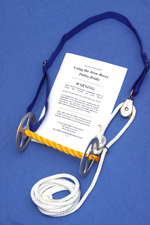What Resistant Horses and Clunky Cars Have In Common
Trainer Andy Curry talks about this today:
Goin’ for a ride soon?
Do you just…’get on’?
Or do you check to see if your horse
woke up on the wrong side of the barn today?
Truly, it’s important to check your
horse before climbing on because if something is wrong…
‘It could be like
sitting on a case
of dynamite!’
No…I’m not kidding.
Let me ask you.
If you got in your car, started the
engine, put it in drive and tried to steer away from where
you were but couldn’t…would you keep driving the car?
Of course not.
What if you also didn’t have any brakes?
Wouldn’t that make it even less desirable to drive?
Of course.
Fact is, lots of horsey people don’t
consider the implications of a horse with no steering or brakes.
You see, if your horse is resistant,
you need to work through it.
But the key is ‘knowing’ if he’s resistant.
How do you do that?
For starters, just look to see if your
horse is compliant and willing.
If it’s soreness, you have to address
that.
After all, if your horse suddenly has a sore back for some reason,
you might get bucked off the second you sit in the saddle or
just as you finish your 3 hour trail ride.
Either time is NOT a good time to be bucked off. (In fact,
I can’t think of any time as a good time for being bucked off)
Now if your horse is resistant from disrespect,
you don’t wanna get on.
That’s another issue all together.
But what if you don’t know what you’re looking for?
You might want to take a look at Linda Braddy and/or
Jim Rea’s videos. (DVD’s)
Both of these trainers address this very problem.
Jim’s video can be seen by clicking here:
Jim Rea Training DVD
And Linda’s video can be seen by clicking here:
Anyway, Linda claims you don’t have to do any ‘preset’
thing to check for resistance – but she shows you
things you can do.
Jim, on the other hand, has a 7-Step Safety plan to
go through before climbing on.
Which is best?
Hard to say.
I like ’em both because both give valuable info.
But the thing I REALLY want you to get out of this… is this.
Look for resistance before you get on. If it’s there,
work through it.
If you can’t, perhaps you shouldn’t ride that horse that day.
If you choose to ride when you shouldn’t,
better check your health insurance – you may need it.
There ya go… words of wisdom you can put into use or the bank…
Work with and enjoy your horses…. just do it safely.
Charlie
P.S. New to riding and all this sounds a bit too much right now?
There’s no better way to get started than learning all the basics
BEFORE you start lessons or climb on a horse. This book and the
lessons inside will safe many times the cost. Read about our:
“Horseback Riding: The Complete Beginner’s Guide”
You can see it here:
Horseback Riding: The Complete Beginner’s Guide
+++++++++++++++++++++++++++++++++++++++++++++++++++++++++++++++++
The “8 volume Beery Illustrated Course in Horse Training” has long
been out of print but we secured the reprint rights for it and
spent hundreds of dollars to have it professionally converted
(re-typed and scanned the original illustrations) to a
new book form. We sell it both as a printed book and as
digital downloads.
Beery’s methods work just as well today as they did 100 years ago
and he presents them in an easy to use form.
Anyone who reads the books and diligently tries them
on their horse will succeed.
But success isn’t without work. Heck – few things are.
Get the course, read it, and apply the methods to fix your
main training problems. See if it doesn’t work for you.
Read the testimonials from just a few of the folks that wrote
in. I have dozens more. It will work for you, too.
If your horse is in need of some work, if he’s getting dangerous
or has you fearful then now is the time to start fixing these
problems.
Here’s the link. Click it and read more about Beery’s course now:
Jesse Beery Illustrated Course in Horse Training
+++++++++++++++++++++++++++++++++++++++++++++++++++++++++++++++++++++


